这里分享下我在日常开发中对 Gradle 的常用配置规则
一、版本号配置
当项目逐渐演进的过程中,主工程依赖的 Module 可能会越来越多,此时就需要统一配置各个 Module 的编译参数了
在工程的根目录下新建一个 gradle 文件,命名为 config.gradle ,在此文件中统一声明工程的编译属性和依赖库的版本号
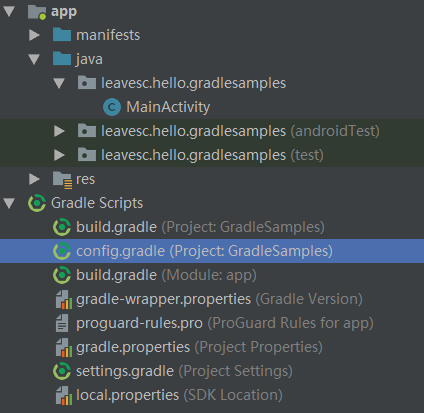
ext { compileSdkVersion = 28 minSdkVersion = 15 targetSdkVersion = 28 versionCode = 1 versionName = '1.0' dependencies = [ appcompatV7 : 'com.android.support:appcompat-v7:28.0.0-rc02', constraintLayout: 'com.android.support.constraint:constraint-layout:1.1.3', junit : 'junit:junit:4.12', testRunner : 'com.android.support.test:runner:1.0.2', espressoCore : 'com.android.support.test.espresso:espresso-core:3.0.2' ]} 默认情况下, App Module 的 build.gradle 文件的默认配置如下所示
apply plugin: 'com.android.application'android { compileSdkVersion 28 defaultConfig { applicationId "leavesc.hello.gradlesamples" minSdkVersion 15 targetSdkVersion 28 versionCode 1 versionName "1.0" testInstrumentationRunner "android.support.test.runner.AndroidJUnitRunner" } buildTypes { release { minifyEnabled false proguardFiles getDefaultProguardFile('proguard-android.txt'), 'proguard-rules.pro' } }}dependencies { implementation fileTree(dir: 'libs', include: ['*.jar']) implementation 'com.android.support:appcompat-v7:28.0.0-rc02' implementation 'com.android.support.constraint:constraint-layout:1.1.3' testImplementation 'junit:junit:4.12' androidTestImplementation 'com.android.support.test:runner:1.0.2' androidTestImplementation 'com.android.support.test.espresso:espresso-core:3.0.2'} 这里将其改为引用 config.gradle 文件的形式
首先,需要在根目录下的 build.gradle 文件中应用 config.gradle 文件,这样在 Module 配置文件中才引用得到当中的属性值
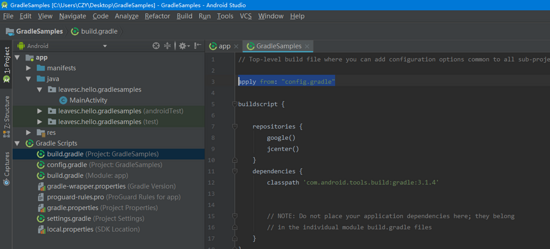
此时就可以修改应用版本号以及依赖库的声明方式了
apply plugin: 'com.android.application'def globalConfiguration = rootProject.extdef presentationDependencies = globalConfiguration.dependenciesandroid { compileSdkVersion globalConfiguration["compileSdkVersion"] defaultConfig { applicationId "leavesc.hello.gradlesamples" minSdkVersion globalConfiguration["minSdkVersion"] targetSdkVersion globalConfiguration["targetSdkVersion"] versionCode globalConfiguration["versionCode"] versionName globalConfiguration["versionName"] testInstrumentationRunner "android.support.test.runner.AndroidJUnitRunner" } buildTypes { release { minifyEnabled false proguardFiles getDefaultProguardFile('proguard-android.txt'), 'proguard-rules.pro' } }}dependencies { implementation fileTree(include: ['*.jar'], dir: 'libs') implementation presentationDependencies.appcompatV7 implementation presentationDependencies.constraintLayout testImplementation presentationDependencies.junit androidTestImplementation presentationDependencies.testRunner androidTestImplementation presentationDependencies.espressoCore} 这样,即使以后工程中包含多个 Module ,只要配置的属性都是来自于 config.gradle 文件,就可以做到统一修改编译属性与依赖库版本了
二、签名属性配置
通常,应用的签名类型会分为 release 和 debug 两类,并分别使用不同的签名文件
为了安全考虑以及实现自动化打包,可以通过 gradle 来声明签名配置,包括签名文件路径、签名别名、签名密码等
在 local.properties 文件中声明签名文件路径以及签名密码
sdk.dir=C/://Software//SDKkey.keyStorePath=..//doc//key.jkskey.keyAlias=leavesCkey.keyPassword=987654321key.storePassword=123456789
根据配置可知,签名文件是放在工程的 doc 文件夹内
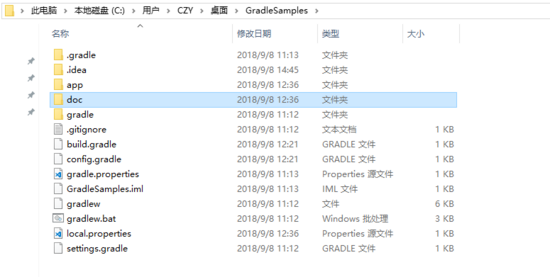
通过代码获取到签名的各个配置项
Properties properties = new Properties()properties.load(project.rootProject.file('local.properties').newDataInputStream())def keyStorePath_ = properties.getProperty("key.keyStorePath")def storePassword_ = properties.getProperty("key.storePassword")def keyAlias_ = properties.getProperty("key.keyAlias")def keyPassword_ = properties.getProperty("key.keyPassword")def storeFile_ = file(keyStorePath_) 配置不同的签名属性以及 build 类型
signingConfigs { release { storeFile storeFile_ storePassword storePassword_ keyAlias keyAlias_ keyPassword keyPassword_ v1SigningEnabled true v2SigningEnabled true } debug { storeFile storeFile_ storePassword storePassword_ keyAlias keyAlias_ keyPassword keyPassword_ v1SigningEnabled true v2SigningEnabled true } } buildTypes { debug { minifyEnabled false proguardFiles getDefaultProguardFile('proguard-android.txt'), 'proguard-rules.pro' signingConfig signingConfigs.debug } release { minifyEnabled true proguardFiles getDefaultProguardFile('proguard-android.txt'), 'proguard-rules.pro' signingConfig signingConfigs.release } } 此处,我配置了两种不同的 buildType : debug 、 release ,并对应不同的签名文件
以后只要选定不同的 Build Variant ,即可打包具体签名的 Apk 文件
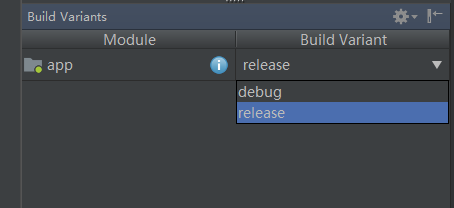
而 local.properties 文件可以保存到服务器来实现远程打包,从而保证了隐私安全
三、多渠道打包
有时候,为了方便进行精准营销,会有生成不同渠道包的要求,此时就需要在同个应用上打上不同的渠道ID(channelId),这可以通过 productFlavors 来实现
先在 AndroidManifest.xml 文件中配置占位符, appKey 即对应各个渠道的 ID 值
<meta-data android:name="APP_KEY" android:value="${appKey}" /> 在 gradle.properties 文件中声明需要的 ChannelId 以及对应的 ApplicationId ,在此文件中声明的属性可以直接在 build.gradle 中直接获取到
#默认配置defaultApplicationId=leavesc.hello.gradlesamples##各个渠道的配置#应用宝yingyongbaoChannelId="yingyongbao"yingyongbaoApplicationId=leavesc.hello.gradlesamples.yingyongbaoyingyongbaoAppKey=appKey_yingyongbao#豌豆荚wandoujiaChannelId="wandoujia"wandoujiaApplicationId=leavesc.hello.gradlesamples.wandoujiawandoujiaAppKey=appKey_wandoujia#小米xiaomiChannelId="xiaomi"xiaomiApplicationId=leavesc.hello.gradlesamples.xiaomixiaomiAppKey=appKey_xiaomi
productFlavors 可以理解为是对同个产品的不同“风味要求”,可以根据配置项生成特定风味的产品(App)
例如,此处就为不同渠道设定了不同的 applicationId
buildConfigField 属性则用于在 BuildConfig.java 文件中生成特定类型的字段,此处就生成了一个类型为 String ,名为 channelId 的字段,用于方便在应用运行过程中判断当前应用的渠道类型
manifestPlaceholders 就是用于替换 AndroidManifest.xml 文件中的指定占位符了
productFlavors { yingyongbao { applicationId yingyongbaoApplicationId buildConfigField "String", "channelId", yingyongbaoChannelId manifestPlaceholders = [appKey: yingyongbaoAppKey] } wandoujia { applicationId wandoujiaApplicationId buildConfigField "String", "channelId", wandoujiaChannelId manifestPlaceholders = [appKey: wandoujiaAppKey] } xiaomi { applicationId xiaomiApplicationId buildConfigField "String", "channelId", xiaomiChannelId manifestPlaceholders = [appKey: xiaomiAppKey] } } 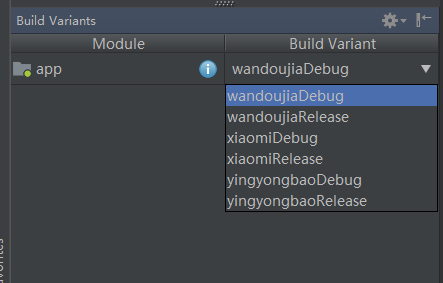
在主布局文件中展示当前应用的各项属性值
@Override protected void onCreate(Bundle savedInstanceState) { super.onCreate(savedInstanceState); setContentView(R.layout.activity_main); StringBuilder sb = new StringBuilder(); sb.append("ApplicationId: "); sb.append(getApplicationInfo().packageName); sb.append("/n"); sb.append("ApplicationName: "); sb.append(getString(getApplicationInfo().labelRes)); sb.append("/n"); sb.append("ChannelId: "); sb.append(BuildConfig.channelId); sb.append("/n"); try { ApplicationInfo appInfo = getPackageManager().getApplicationInfo(getPackageName(), PackageManager.GET_META_DATA); String appKey = appInfo.metaData.getString("APP_KEY"); sb.append("AppKey: "); sb.append(appKey); } catch (PackageManager.NameNotFoundException e) { e.printStackTrace(); } TextView tv_appInfo = findViewById(R.id.tv_appInfo); tv_appInfo.setText(sb); ImageView iv_log = findViewById(R.id.iv_log); iv_log.setImageResource(getApplicationInfo().icon); } 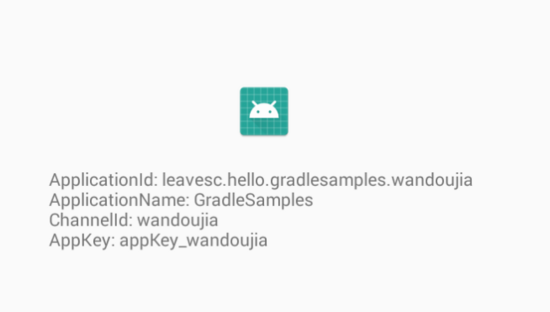
四、打包时指定 Apk 名字
为了方便标识各个测试包的版本已经打包时间,可以通过 Gradle 来指定生成的 Apk 文件的命名规则
例如,以下配置就根据 buildType、flavorName 和 编译时间 来命名 Apk 文件
applicationVariants.all { variant -> def buildType = variant.buildType.name def flavorName = variant.flavorName def createTime = new Date().format("YYYY-MM-dd_hh_mm_ss", TimeZone.getTimeZone("GMT+08:00")) variant.outputs.all { outputFileName = flavorName + "_" + buildType + "_v" + defaultConfig.versionName + "_" + createTime + ".apk" } } 
五、生成属性字段与资源文件值
上边讲过, buildConfigField 属性可用于在 BuildConfig.java 文件中生成特定类型的字段,此处可以利用其来记录应用的编译时间
此外,也可以利用 resValue 来生成一个 ID 引用类型的 string 字符串
首先,声明两个方法,分别用于获取当前时间以及当前电脑的用户信息
static def buildTime() { return new Date().format("yyyy-MM-dd HH:mm:ss")}static def hostName() { return System.getProperty("user.name") + "@" + InetAddress.localHost.hostName} defaultConfig { applicationId defaultApplicationId minSdkVersion globalConfiguration["minSdkVersion"] targetSdkVersion globalConfiguration["targetSdkVersion"] versionCode globalConfiguration["versionCode"] versionName globalConfiguration["versionName"] testInstrumentationRunner "android.support.test.runner.AndroidJUnitRunner" flavorDimensions '1' resValue "string", "build_host", hostName() buildConfigField "String", "build_time", "/"" + buildTime() + "/"" } 用代码来获取这两个属性值
@Override protected void onCreate(Bundle savedInstanceState) { super.onCreate(savedInstanceState); setContentView(R.layout.activity_main); StringBuilder sb = new StringBuilder(); sb.append("ApplicationId: "); sb.append(getApplicationInfo().packageName); sb.append("/n"); sb.append("ApplicationName: "); sb.append(getString(getApplicationInfo().labelRes)); sb.append("/n"); sb.append("ChannelId: "); sb.append(BuildConfig.channelId); sb.append("/n"); sb.append("BuildTime: "); sb.append(BuildConfig.build_time); sb.append("/n"); sb.append("BuildUser: "); sb.append(getString(R.string.build_host)); sb.append("/n"); try { ApplicationInfo appInfo = getPackageManager().getApplicationInfo(getPackageName(), PackageManager.GET_META_DATA); String appKey = appInfo.metaData.getString("APP_KEY"); sb.append("AppKey: "); sb.append(appKey); } catch (PackageManager.NameNotFoundException e) { e.printStackTrace(); } TextView tv_appInfo = findViewById(R.id.tv_appInfo); tv_appInfo.setText(sb); ImageView iv_log = findViewById(R.id.iv_log); iv_log.setImageResource(getApplicationInfo().icon); } 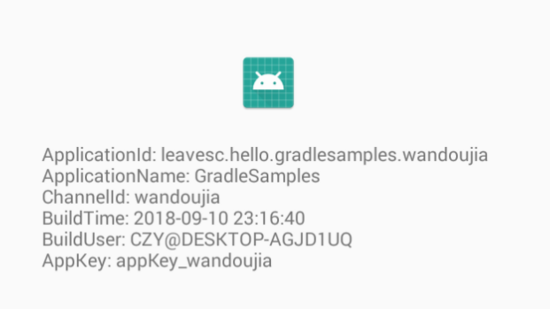
六、替换资源文件
在多渠道打包时,除了需要在应用中打上特定的标签外,也可能需要使之使用不同的资源文件,例如应用图标和应用名称
此时可以以各个 productFlavor 的名称来命名相应的文件夹,并在其中放置相应的图标文件以及声明了应用名称的 string.xml 文件,这样在多渠道打包时,Gradle 就会自动引用相应的资源文件
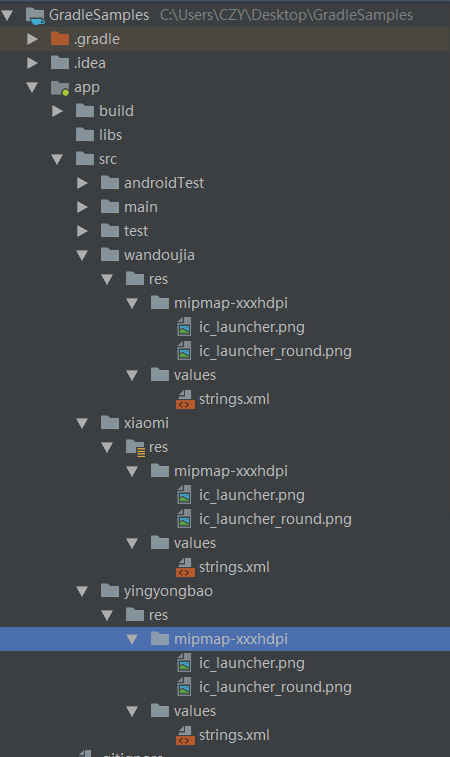

上述所有的示例代码可以在这里获取: GradleSamples
以上就是本文的全部内容,希望对大家的学习有所帮助,也希望大家多多支持VEVB武林网。
注:相关教程知识阅读请移步到Android开发频道。